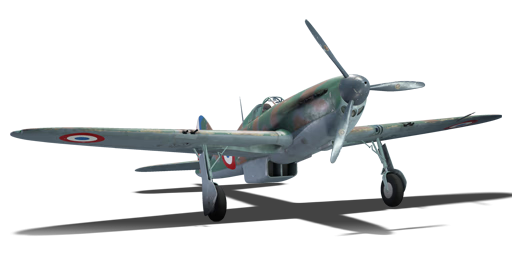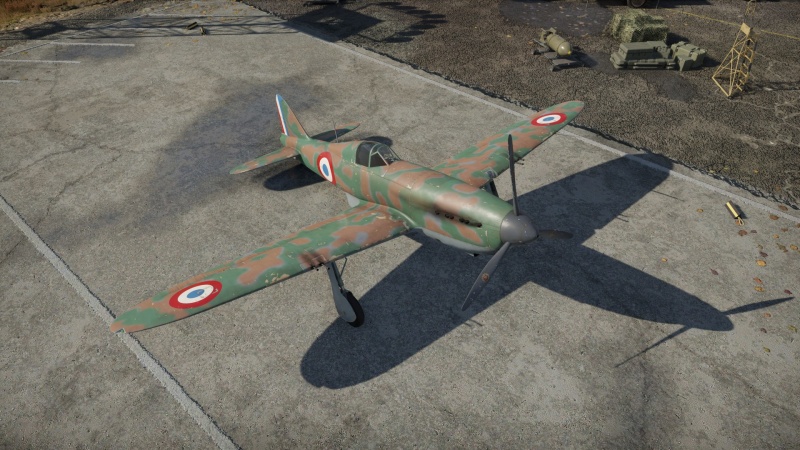Difference between revisions of "V.G.33C-1"
(→Usage in battles: Filled the history tab and added to "Usage In Battles") (Tag: Visual edit) |
(→Pros and cons) (Tag: Visual edit) |
||
| Line 143: | Line 143: | ||
* Amazing energy retention, probably the best for what it faces (up to 3.7 battle rating). | * Amazing energy retention, probably the best for what it faces (up to 3.7 battle rating). | ||
* Lightweight can zoom climb away from most enemies in the middle of a dogfight | * Lightweight can zoom climb away from most enemies in the middle of a dogfight | ||
| + | * High energy retention when exiting a dive | ||
'''Cons:''' | '''Cons:''' | ||
| Line 152: | Line 153: | ||
* No combat take-off flaps | * No combat take-off flaps | ||
* The engine overheats quickly at low altitude (below 4,000 m, or 12,000 ft) | * The engine overheats quickly at low altitude (below 4,000 m, or 12,000 ft) | ||
| + | * Inline engine cannot sustain damage | ||
== History == | == History == | ||
Revision as of 14:08, 7 August 2021
Contents
Description
The V.G.33C-1 is a rank II French fighter with a battle rating of 3.0 (AB) and 2.7 (RB/SB). It was introduced in Update 1.73 "Vive la France".
The V.G.33 can adequately deal with planes with similar BR. It is quick, nimble (to an extent), and powerful. Its machine guns and single propeller-mounted 20 mm do a decent amount of damage. However, it lacks armour, so take that into account when engaging other aircraft.
General info
Flight performance
| Characteristics | Max Speed (km/h at 4,500 m) |
Max altitude (metres) |
Turn time (seconds) |
Rate of climb (metres/second) |
Take-off run (metres) | |||
|---|---|---|---|---|---|---|---|---|
| AB | RB | AB | RB | AB | RB | |||
| Stock | 537 | 523 | 9500 | 19.7 | 20.5 | 10.4 | 10.4 | 300 |
| Upgraded | 588 | 558 | 18.8 | 19.0 | 20.4 | 13.4 | ||
Details
| Features | ||||
|---|---|---|---|---|
| Combat flaps | Take-off flaps | Landing flaps | Air brakes | Arrestor gear |
| X | X | ✓ | X | X |
| Limits | ||||||
|---|---|---|---|---|---|---|
| Wings (km/h) | Gear (km/h) | Flaps (km/h) | Max Static G | |||
| Combat | Take-off | Landing | + | - | ||
| 0 | 320 | N/A | N/A | 270 | ~12 | ~9 |
| Optimal velocities (km/h) | |||
|---|---|---|---|
| Ailerons | Rudder | Elevators | Radiator |
| < 350 | < 350 | < 430 | > 340 |
| Compressor (RB/SB) | ||
|---|---|---|
| Setting 1 | ||
| Optimal altitude | 100% Engine power | WEP Engine power |
| 4,000 m | 860 hp | 965 hp |
Survivability and armour
- 3 mm Steel plate between engine and oil cooling system.
Modifications and economy
Armaments
Offensive armament
The V.G.33C-1 is armed with:
- 1 x 20 mm Hispano 404 cannon, nose-mounted (60 rpg)
- 4 x 7.5 mm MAC 1934 machine guns, wing-mounted (500 rpg = 2,000 total)
Usage in battles
The V.G is a very competitive aircraft at its Battle Rating, with decent climb rate, good speed and good manoeuvrability. Its biggest weaknesses are its lack of ammo and lack of armour. To take advantage of this plane it's best to side climb and exploit any opportunities that are spotted. Both turn fighting and BnZ tactics work well with this plane but turn fighting is the better of the two due to the lack of ammo, it also allows for, generally speaking, a better and cleaner shot. Trigger control is key when flying this. Though not as manoeuvrable as a spitfire, it can sustain a turn fight with an F6F, Yak 7 and Yak 9s, but fighting something like a I-16, you can use your high horsepower engine turn upwards, dodging out of the way of its guns, he will eventually stall out and you can finish him off with your 7.5 mms.
In Ground forces, with only 17mm of penetration on your Hs 404 at 500m, you are limited with your anti tank capabilities. At the range you are firing at, you can penetrate the roof of the Pz.3 J1, and perhaps the engine deck, depending on angle. Your main target shouldn't be ground forces, but Light attackers and fighters. With your relatively weak armament, bombers will be tough to bring down, and the fragile inline engine cannot take much fire before becoming operational.
Manual Engine Control
| MEC elements | ||||||
|---|---|---|---|---|---|---|
| Mixer | Pitch | Radiator | Supercharger | Turbocharger | ||
| Oil | Water | Type | ||||
| Not controllable | Controllable Not auto controlled |
Controllable Not auto controlled |
Controllable Not auto controlled |
Separate | Not controllable 1 gear |
Not controllable |
Pros and cons
Pros:
- 20 mm cannon is very dangerous, especially with high explosive ammunition
- Relatively fast
- Excellent manoeuvrability
- Impressive efficiency of 4 x 7.5 mm MAC 1934 machine guns
- Amazing climb rate, about as good as the BF-109s
- Excellent high altitude performance, better than the P-38G-1 Lightning, at the battle rating of 3.3
- Amazing energy retention, probably the best for what it faces (up to 3.7 battle rating).
- Lightweight can zoom climb away from most enemies in the middle of a dogfight
- High energy retention when exiting a dive
Cons:
- 20 mm cannon has very small ammo pool
- 20 mm cannon under-performs until you research new ammunition belts
- Too weak, especially the fuel tanks
- Below average roll rate
- No combat take-off flaps
- The engine overheats quickly at low altitude (below 4,000 m, or 12,000 ft)
- Inline engine cannot sustain damage
History
The original specification that led to the VG series was offered in 1936 in order to quickly raise the number of modern aircraft in French service, by supplying a "light fighter" of wooden construction that could be built rapidly in large numbers. The contract resulted in three designs, the VG-30, the Caudron C.714 and the Bloch MB.700. Prototypes of all three were ordered.
Named for engineer Michel Vernisse (V) and designer Jean Galtier (G), the VG-30 was all wooden in construction, using plywood over stringers in a semi-monocoque construction. The layout was conventional, a low-wing monoplane that bore a striking resemblance to the later Italian Macchi C.202. Armament consisted of a 20 mm Hispano-Suiza HS.404 engine-mount moteur-canon firing through the propeller hub, and four 7.5 mm MAC 1934 M39 drum-fed machine guns, two in each wing. The design was supposed to be powered by the Potez 12Dc flat-12 air-cooled inline engine, but this ran into development problems. The prototype was then fitted with a Hispano-Suiza 12Xcrs instead, and flew in this form in October 1938.
In order to find some solution to the engine problem, the VG-31 was to use the 632 kW (860 hp) Hispano-Suiza 12Y-31 and the VG-32 the Allison V-1710C-15. The VG-31 flew in 1939 and proved to have excellent performance. The prototype VG-32 was completed in 1940 and awaiting its test flight when it was captured by the advancing German forces at Villacoublay.
The VG-33 was a modified version of the VG-31 using the same 12Y-31, and first flew on April 25, 1939. It had a surprisingly good performance of 560 km/h (348mph), and was ordered into production with a contract for 220 aircraft in September, later raised to 1,000. Production did not take long to start, but most of the airframes never received engines and sat at the factory when it fell to the Germans.
Source: https://en.wikipedia.org/wiki/Arsenal_VG-33
Media
- Skins
- Videos
See also
Links to the articles on the War Thunder Wiki that you think will be useful for the reader, for example:
- reference to the series of the aircraft;
- links to approximate analogues of other nations and research trees.
External links
| Arsenal Aeronautical (Arsenal de l'Aéronautique) | |
|---|---|
| Fighters | VB.10-02 · VB.10C-1 |
| V.G.33C-1 | |
| France fighters | |
|---|---|
| Dewoitine | D.371 · D.371 H.S.9 · D.373 · D.500 · D.501 · Pallier's D.510 · D.520 |
| Morane-Saulnier | M.S.405C1 · M.S.406C1 · M.S.410 |
| Arsenal | V.G.33C-1 |
| Bloch | M.B.152C1 · M.B.157 |
| Caudron | C.R.714 |
| Sud-Ouest | S.O.8000 Narval |
| American | H-75A-1 · H-75A-4 · ▄P-39Q-25 · ▄P-40F-5 Lafayette · ▄P-47D-22-RE · ▄P-63C-5 · F-6C-10-NA |
| ▄F6F-5 · ▄F6F-5N · F4U-7 · ▄F8F-1B | |
| Other countries | ▄Seafire LF Mk.III · ▄Yak-3 · Challe's ▄Yak-9T · NC.900 |
| Belgium | ▄Gladiator Mk I · ▄Spitfire FR Mk XIVe |
| Netherlands | ◘Sea Fury FB 51 |





